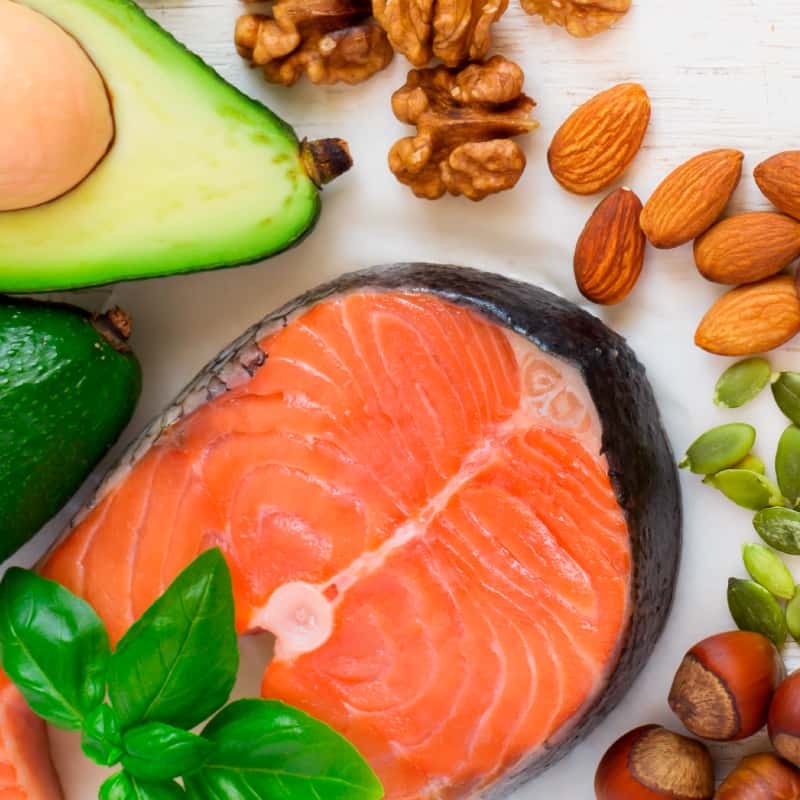This Dr. Axe content is medically reviewed or fact checked to ensure factually accurate information.
With strict editorial sourcing guidelines, we only link to academic research institutions, reputable media sites and, when research is available, medically peer-reviewed studies. Note that the numbers in parentheses (1, 2, etc.) are clickable links to these studies.
The information in our articles is NOT intended to replace a one-on-one relationship with a qualified health care professional and is not intended as medical advice.
This article is based on scientific evidence, written by experts and fact checked by our trained editorial staff. Note that the numbers in parentheses (1, 2, etc.) are clickable links to medically peer-reviewed studies.
Our team includes licensed nutritionists and dietitians, certified health education specialists, as well as certified strength and conditioning specialists, personal trainers and corrective exercise specialists. Our team aims to be not only thorough with its research, but also objective and unbiased.
The information in our articles is NOT intended to replace a one-on-one relationship with a qualified health care professional and is not intended as medical advice.
It’s Official: Poor Diets Kill (More Than Tobacco!)
April 9, 2019

According to findings from a recent systematic analysis published in The Lancet, an estimated 11 million deaths per year (1 in every 5 deaths) are directly due to eating a poor diet. As CBS News sums it up, “Unhealthy diets now kill more people than tobacco and high blood pressure.”
While it’s no surprise that eating an unhealthy diet increases your risk for a number of chronic diseases, this large scale analysis has revealed that on a global scale poor diets are responsible for more deaths than any other risk factors.
The Study That Shows Poor Diets Are Leading Cause of Death
The Lancet analysis reviewed data on consumption of 15 different food groups in 195 countries, tracked over a 27-year period, from 1990 to 2017. The goal of the analysis was to draw conclusions about how dietary trends affect the risk of developing diseases and dying as a consequence.
Researchers estimated the proportion of disease-specific burden attributable to 15 dietary risk factors. Food groups that were tracked as part of the study included: fruits, vegetables, legumes, whole grains, nuts, seeds, milk, fiber, calcium, seafood omega-3 fatty acids, polyunsaturated fats, red meat, processed meat, sugar-sweetened beverages, trans fatty acids and sodium.
What qualifies as an “unhealthy diet”? Researchers found that the following combination poses the biggest risk to your health:
- Low intake of healthy foods — especially fruits, vegetables, nuts, whole grains and seeds.
- High intake of unhealthy foods — especially foods high in sodium, red meat, processed meat and sugar-sweetened beverages.
Key findings from the study include:
- Eating a diet that is high in sodium, low in whole grains and low in fruit is strongly correlated with an increased risk for diet-related diseases and mortality.
- Low intake of whole grains was the leading risk for deaths and disease among young adults (aged 25–50 years) while sodium ranked first among older adults (≥70 years).
- Not eating enough healthy foods seems to negatively impact health more than with eating too many unhealthy foods. Researchers believe that in many countries, a significant problem is low intake of healthy foods.
- Other major risk factors for disease-related deaths include consuming too much red meat, processed meat, trans fat and sugar-sweetened beverages.
How did different nations compare in terms of diet quality and its impact on disease and death rates?
- Out of the 195 countries included in the analysis, Israel was found to have the the lowest rate of diet-related deaths.
- Uzbekistan was found to have the highest rate of diet-related deaths overall.
- Among the world’s 20 most populous countries, Egypt had the highest age-standardized rate of all diet-related deaths, while Japan had the lowest rate of all diet-related deaths and cardiovascular-related deaths. Japan was among the countries with the lowest intake of processed meats, trans-fats and sweetened beverages, but had a relatively high intake of vegetables, fiber and whole grains.
- The U.S. ranked 43rd in terms of diet-related deaths. Countries categorized as “high-income North America,” including the U.S., had some of the highest consumptions of unhealthy foods like processed meats, sugary drinks, and foods high in sodium and trans-fats.
- China had the highest age-standardized rate of diet-related cardiovascular disease death, while Mexico had the highest rates of diet-related type 2 diabetes deaths.
Deadly Consequences of a Bad Diet
Researchers believe that improvements in diet quality could potentially prevent one in every five deaths globally.
Findings from the analysis showed that:
Globally, consumption of nearly all healthy foods and nutrients was suboptimal in 2017. The largest gaps between current and optimal intake were observed for nuts and seeds, milk, and whole grains. The consumption of sugar-sweetened beverages (49 grams per day) was far higher than the optimal intake. Similarly, global consumption of processed meat and sodium were far above the optimal levels.
What is it about the combination of eating processed, poor quality foods like soda and fried foods — while also skipping out on nutrient-dense foods like vegetables and nuts — that poses the biggest risk to your health? Here are just some of the ways that a bad diet can contribute to early death and disease:
- Raises blood pressure and cholesterol
- Contributes to obesity
- Can cause metabolic syndrome and diabetes
- Contributes to chronic inflammation, gut-related issues and autoimmune diseases
- Negatively impacts neurological health, contributing to cognitive decline
- Harms the kidneys and liver
- Can contribute to depression
The Lancet study specifically focused on how suboptimal diets serve as risk factors for non-communicable diseases (NCDs), which according to the World Health Organization are defined as diseases that cannot be transmitted from one person to another. Some of the most common NCDs globally include: heart diseases, most cancers, type 2 diabetes, chronic kidney disease, osteoarthritis, Parkinson’s disease, autoimmune diseases (like arthritis), strokes, osteoporosis, Alzheimer’s disease and cataracts.
Of the 11 million deaths each year that the analysis found could be attributed to bad diets, 10 million deaths were believed to be due to heart disease, 913,000 deaths from obesity-related cancers and nearly 339,000 deaths from type 2 diabetes.
Men were found to have a higher intake of both healthy and unhealthy foods than did women, presumably because men eat more calories in general. Intake of both healthy and unhealthy foods was generally higher among middle-aged adults (50–69 years) and lowest among young adults (25–49 years). Young adults consumed the most sugar-sweetened beverages and legumes, which showed a decreasing trend with age.
6 Keys to Healthy Eating
According to the study findings, an “optimal amount” — meaning one that is sufficient to help reduce the risk of diet-related diseases — should include:
- Fruit: 200–300 grams per day, or about 2 servings (a medium-sized apple is about 180 grams)
- Vegetables: 290–430 grams per day, or about 3 to 4 servings that are one cup each
- Legumes: 50–70 grams per day, or about 1/3 cup
- Whole grains: 100–150 grams per day, or about 4 servings that are 1/2 cup each
- Nuts and seeds: 16–25 grams per day, or about 1 ounce/1 serving that is roughly 1/4 cup
- Milk: 350–520 grams per day, which is about 12 to 18 ounces
- Red meat: 18–27 grams per day, which is only about one ounce
- Fiber: 19–28 grams per day
- Processed meat: ideally 0 grams, but up to 4 grams per day
- Sweetened beverages: ideally none, but up to 5 grams per day
- Trans-fats: as little as possible, ideally none
1. Replace Refined/Processed Grains with Whole Grains
In a number of countries, eating a diet that lacks whole grains was found to be a leading dietary risk factor. This includes the U.S., where whole grains like brown rice, millet, barley, quinoa, buckwheat, etc. are less commonly eaten than in other nations.
Based on The Lancet study findings, some experts feel that “The ideal scenario would be to focus on healthy replacements for unhealthy foods. That should be the focus of public health interventions.” This means that replacing refined grains like most breads, cereals, pasta, etc. with 100 percent whole, ancient grains is an important step in protecting your health.
2. Reduce Sodium Intake From Processed/Packaged Foods
Consuming high amounts of sodium — found in highly processed foods like cold cuts, canned soups, condiments, etc. — was found to be a leading risk factor in some countries, including many Asian countries.
3. Eat More Fresh Fruit and Less Sugary Foods and Beverages
Eating too little fresh fruit, but getting sugar from sweetened drinks, was found to be a significant risk factor in many nations. A diet low in fruits was found to be single biggest problem in places like sub-Saharan Africa. Some of the healthiest fruits to include in your diet are berries of all kinds, citrus fruits like oranges and grapefruits, kiwi, mango and melon.
4. Incorporate A Variety of Vegetables
While cutting out processed foods from your diet is important, it seems to be even more protective if you focus on increasing intake of healthy foods, especially antioxidant-rich vegetables and fruits (in addition to whole grains, nuts, seeds, and legumes).
Vegetables are some of the most nutrient-dense foods there are, especially considering that they are low in calories and full of phytonutrients, vitamins and minerals. Some of the healthiest choices include cruciferous vegetables like broccoli and kale, dark leafy greens, carrots, bell peppers, asparagus, and tomatoes.
5. Have More Nuts and Seeds
Low intake of nuts and seeds ranked first in Mexico as a risk factor for disease and early death. Nuts and seeds are a great source of healthy polyunsaturated fats, fiber and minerals, making them beneficial for heart health, digestive health, appetite control and more.
Good options include flax seeds, chia seeds, almonds, walnuts and just about all others.
6. Avoid Processed Meat and Trans-Fats
High consumption of red meat, processed meats, and trans fats were observed in many countries and correlated to increased risk of disease. Rather than having processed meats like bacon, sausage, cold cuts, salami etc., go for healthier alternatives including grass-fed meats, pasture-raised poultry and especially wild-caught fish like salmon.
Read Next: Top Causes of Death Worldwide (and How to Avoid Them!)









